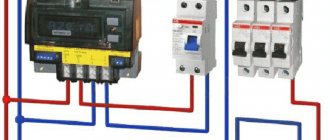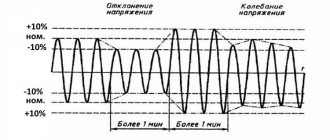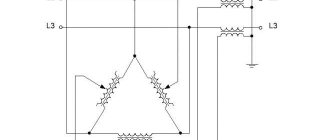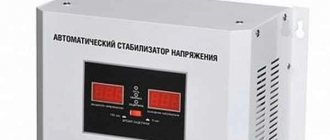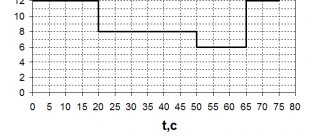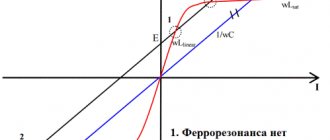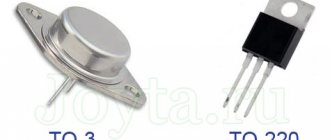Voltage transformation is present everywhere in every area of our lives and activities. The voltage generated at the power plant is increased to several kilovolts in order to be transmitted with minimal losses through power lines over many thousands of kilometers. And then it is again reduced at transformer substations to our usual values of 380/220 volts.
Step-up transformers are not used to stabilize voltage in cases where its value in the network is constantly changing. For home use, only stabilizers are used.
Let's look at the principle of operation of a voltage transformer in more detail, without plunging into unnecessary complications.
Voltage transformer
All windings are wound on a common core (magnetic core). If the number of turns of the secondary winding is greater than that of the primary, then it is a step-up transformer; if less, it is a step-down transformer.
The power of a voltage transformer depends on the cross-section of the winding wires, and the dimensions and weight depend on the type of core and wire material (copper or technical aluminum). In terms of design, it can be single- or three-phase. The most compact and lightest is the autotransformer, which has only one winding.
Effect of power on the number of turns
A transformer made by yourself can be equipped with any number of turns.
The instructions on how to make a transformer indicate that the required number of turns is calculated based on the power of the intended device.
Step-up transformer
The first thought that comes to mind when the voltage in the network becomes low more and more often is to install a step-up transformer. At first glance, it seems that this is a simple and excellent solution, and now, finally, there will be normal voltage, bright lighting and stably operating electrical appliances. For a house or cottage with an allocated power of 5 kW, it will cost just over 19,840 rubles. — Progress AT5000R.
But not everything is so simple in the fairy-tale kingdom, and before you buy a step-up voltage transformer, the price of which is very attractive, think about one feature of its operation: it has a constant coefficient
voltage increase (transformation ratio). Let's look at this with an example.
Let's assume that your mains voltage is about 170 volts. To increase it to 220, you need a transformer with a transformation ratio of 1.29 (220/170). It seems that everything is working out well and logically, except for one thing: if the voltage in the network becomes normal 220 volts, then the output of the transformer will already have a very high voltage of 285 volts (220 * 1.29)! Not all electrical appliances can withstand such overvoltage for even a short time. So it’s not far from the fire!
As an option, you can purchase an adjustable autotransformer, the so-called. LATR, which provides a manual output voltage regulator. But it will not be a reliable solution, because... you will have to constantly monitor the value of the output voltage using the indicator and adjust it manually, especially during maximum load on the power grid from neighbors. If this is not done in time, then at the first surge in the power grid, the voltage at the output of the LATR will also rise sharply, and the connected electrical appliances may well burn out.
Therefore, step-up voltage transformers are applicable only when the network is ALWAYS significantly less than 220 volts, and this almost never happens
.
Classification and types
Transformers are divided into several types depending on their application and technical characteristics. The main classification parameters are:
- Number of windings.
- Number of phases.
- Cooling method.
- Accuracy class or possible errors.
- Type of allocation.
Transformers designed to regulate electric current are called current transformers. If the device regulates voltage, then it is called a voltage transformer.
The voltage varies depending on the number of transformer windings:
- The primary takes the voltage.
- The secondary transmits the changed voltage.
A transformer for a home is called a step-up transformer if it has more turns in the secondary winding than in the primary, otherwise it is a step-down transformer.
The cross-section of the winding wires affects the power of the transformer, the materials used to make the wires and the type of core affect the size and weight of the device. All devices according to the type of execution are divided into three-phase and single-phase.
The simplest transformer with minimal weight and compact dimensions is considered to be an autotransformer with one winding. Such models are budget options and are most often used in automatic devices and high-voltage electrical networks. Autotransformers do not have galvanic isolation, which is their disadvantage.
Power transformers are used to supply and receive electricity to and from power lines. Electrical appliances are equipped with network devices.
Powerful transformer voltage stabilizer
Old tube TVs have power transformers in the device, from which you can make a powerful voltage stabilizer. They must be connected according to a special circuit.
First, you need to remove the power transformers from old TVs. Solder or bite off the suitable wires to the transformer. Then the primary windings are connected to the filament windings in a series circuit so that the filament windings are connected in the opposite direction from the mains winding. To accomplish this, you need to connect the beginning and the end.
On the side of the transformer housing all markings of the windings and their terminals are indicated. The beginning of the winding is marked at the top with a stroke near the number.
The transformers connected together must be placed in an insulated box, and the wires of the connected transformers must be connected to external terminals. The consumer is connected to the stabilizer in a series circuit.
Using the same method, you can regulate the power of the device by reducing or increasing the number of power transformers. This method is effective if the load is suitable for the transformer's capacity. For low power, select the appropriate power of transformers.
Tips for choosing
Before purchasing a voltage stabilizer, you need to decide whether it is needed or not, but for preventive purposes it is still worth installing, since the voltage in electrical networks often varies.
When choosing a mini-transformer, the following characteristics are taken into account:
- Number of phases.
- Output power.
- Weight of the device.
- Transformer dimensions.
- Operational life.
- Operating voltage range.
- Speed of reaction to power surges.
The load of specific devices must be clarified. Single-phase transformers are purchased for low-power household appliances, three-phase stabilizers are purchased for a large number of devices that require load distribution.
One of the most popular and sought-after transformers is the Resanta ASN, a single-phase digital stabilizer with an affordable price of 2,600 rubles. This transformer is mounted on the wall.
A more expensive and reliable model is the Shtil stabilizer. Its approximate cost is 4,000 rubles. The Shtil stabilizer is optimally suited for protecting electronic equipment and household appliances at alternating voltage.
Voltage transformers
Voltage transformers are static electromagnetic devices that change alternating voltage. Such stabilizers are divided into several categories depending on their purpose:
- Power. They are used to increase and decrease voltage, which allows current to be transmitted over long distances and to consumer devices.
- Technological. High-power devices used for technological purposes - furnace, welding and others.
- Low-power. Installed on television and radio equipment, household appliances and various electronic circuits.
- Measuring. Used to expand the measurement boundaries of devices.
Voltage transformers can be used for both monitoring and measuring voltage and power. They can power alarm systems, electrical automation circuits and effectively protect power lines.
Transformer models of stabilizers 220 volts
The circuitry of such household stabilizers differs from other devices. In them, the control unit is connected directly to the regulator. There is a diode bridge behind the filter system. A transistor circuit is provided to equalize the oscillations. After the winding, there is a capacitor at the output.
The transformer copes with system overloads. The current is also converted using a transformer. In general, the power range of such devices is much higher compared to other devices. Such a voltage stabilizer can function even in cold weather. In terms of noise creation, they do not differ much from other similar models. Sensitivity largely depends on the manufacturer and type of regulator installed.
Step-up transformers
These are power devices installed in electrical circuits for household or industrial purposes and increasing voltage. Depending on the area of use and characteristics, transformers for the home are divided into several types that supply voltage:
- Autotransformer. Single-phase single-winding device.
- Current transformer. A stabilizer consisting of a core, several windings, optical sensors and resistors.
- Power devices. Current transfer between circuits is carried out using electromagnetic induction.
- Anti-resonance stabilizers. Closed single-phase or three-phase devices.
- Grounded transformers. Equipped with a special type of winding.
- Peak transformers. Separate alternating and direct currents.
- Transformers for the home. Designed to transfer electricity from a source to a consumer device and eliminate interference in the operation of household devices.
Home Step Up Transformers
They are installed in situations where the voltage of the electrical network is less than the required 220 V. Such models have a constant transformation ratio: with a stable voltage of the electrical network, the final figure will be significantly higher than that required to power electrical appliances, which can cause their breakdown. Output voltage control is provided on some models in manual mode. Industrial transformers cannot be installed at home, as their operation can be dangerous due to the use of specialized cooling oils.
Widest scope of application
The simplicity of assembly and high efficiency of transformers became the reason for their inclusion in the composition:
- Power supplies;
- TVs;
- Microwave ovens;
- Radio stations;
- Welding machines;
- Communication equipment;
- All kinds of automation
- Control and measuring equipment.
Step-down transformers
To connect devices for which the voltage of 220 V is too high, step-down transformers of 15 or 10 volts are installed. The advantages of such transformers for the home are the following characteristics:
- Protection against fire and electric shock, which is important when using such devices in rooms with high levels of humidity - bathrooms, bathhouses and others.
- Minimum electricity consumption - low-voltage lighting devices consume several times less energy, unlike standard ones.
- Increasing the service life of devices.
Chargers for various gadgets and household devices are equipped with integrated transformers, and therefore they do not require the installation of such stabilizers. Self-installation of transformers for the home is necessary when installing low-voltage lighting based on halogen and LED lamps.
Best Step Down Transformers for 2022
Gals ET-190E 60 W
The device is designed for low-voltage halogen lamps (12 V). The maximum power of the transformer is 60 W. The device operates from a regular household network (220 V). The maximum length of the wire to the lamp should not exceed 2 meters.
transformer Gals ET-190E 60 W
Advantages:
- small sizes;
- smooth start;
- noiselessness;
- low cost.
Flaws:
- no short circuit protection.
CVGaudio T-20/16
A step-down transformer is used in speaker systems (16o hm), which are connected to the broadcast line. The device is equipped with four outputs for discharging different powers and connects a speaker with a nominal power of 20/10/5/2.5W in 100V mode. It has 2 legs, which, thanks to special holes, can be fixed to the body of the audio system. Its recommended power is 30-50W (16o hm).
transformer CVGaudio T-20/16
Advantages:
- reasonable price;
- The delivery set includes a 15 m long cable for connection, its ends are stripped and tinned;
- multi-colored cables for easy connection;
- does not distort the sound.
Flaws:
- low permissible power of the audio system.
TR-08 8V AC
A small compact device is designed to power household appliances that do not require a stabilizing voltage, the maximum power of which is 8V. It is allowed to work together with a stabilizer.
transformer TR-08 8V AC
Advantages:
- operation is possible at temperatures from -25 to 35 C;
- protect thermal protection triggered at a temperature of +115 C;
- compact dimensions;
- reliable fastening with screw clamps;
- The maximum output current power is 1A.
Flaws:
- There is no short circuit fuse.
Summary
Purchasing a transformer for home use in most cases is a necessary decision and is not difficult if you carefully study the classification of devices and their purpose. Correct selection of stabilizers provides the power necessary for the operation of household appliances without the risk of equipment breakdown and failure. Installation of transformers can be done either independently or after contacting specialists.
Unstable voltage in the electrical network is a frequent problem and entails unpleasant consequences from breakdowns of electrical appliances to damage to electrical wiring and fires. A wide variety of problems can be partially solved by installing a home transformer - a statistical electrical device used to convert electric current or voltage.
Problems in electrical networks
Electricity is initially supplied through power lines from the supplier's step-up transformers and can travel up to several hundred kilometers to an individual home. When installing a step-down unit on several consumer houses, the loads will be divided between all connected houses.
It is much more profitable, although more expensive, to install an individual transformer for the home - in this way the internal electrical network will receive a current reduced to 220V.
In cases where there is a regular voltage drop in the electrical network, in which the devices are not able to function at full capacity, the problem can be solved by installing a step-up transformer.
Technological connection to electrical networks
- Required power calculator - an approximate calculation of the need for electrical power to submit an application for technological connection;
- Cost calculator - approximate calculation of the cost of technological connection to electrical networks, depending on the type of connection (existing or new);
- Connection stages - a detailed description of the main stages required for technological connection to electrical networks;
- Answers of JSC Lenenergo to frequently asked questions on the technological connection of additional capacity or new capacity and the conclusion of an energy supply agreement.
Types and classification
Depending on the technical properties and scope of application, transformers are classified quite differently. The main parameters for classifying transformers are:
- number of phases;
- number of windings;
- accuracy class – fluctuations in the maximum possible error values;
- cooling method;
- type of placement.
If the operation of the transformer is aimed at regulating the electric current, then the device is called a current transformer. In the case where the device is designed to regulate voltage, it will be a voltage transformer.
The direction of voltage changes is influenced by such an indicator as the ratio of the number of windings of the device:
- primary, receiving voltage;
- secondary, transmitting the changed value of the electric current voltage.
In the case when the transformer has a greater number of turns in the secondary winding than in the primary, it is classified as step-up, and with a smaller number, it is classified as step-down.
The power of the transformer is affected by the cross-section of the winding wires, and the weight and size are affected by the type of core and wire materials. Based on their design, transformers are divided into single-phase and three-phase.
The lightest and smallest autotransformer is considered to be one with only one winding. Also, autotransformers are the most budget option and are often used in automatic control devices, and are also used in high-voltage electrical networks. The only drawback of such a transformer is the lack of galvanic isolation.
What is a single-phase transformer?
Single-phase transformers are devices designed to reduce input voltage. They are used mainly for safety reasons, and sometimes for specific technical requirements (for example for LED lighting). They are also used quite often in everyday life - much more often than you might imagine, although, of course, they may look completely different than traditional transformers.
A single-phase transformer is a simple design that consists of a core and two windings. As electric current passes through the primary winding, a flow of current is induced in the secondary winding.
One of the most commonly used options for home transformers is the so-called bell transformer. It has a secondary winding selected in such a way that from the main network voltage it can be reduced to 3, 8, 12, and sometimes up to 24 V. These are, of course, not all parameters, since depending on your needs you can use different types of transformers that allow you to obtain a wide variety of voltages.
It should be added that the transformer components also include safety elements: thermal and time delay, corresponding to the supply voltage. Although their presence is not required for the voltage change itself, they are very useful for functional reasons.
Transformer operation status
To fully understand the operation of a transformer, it is not enough to know its structure. For complete safety and efficient operation of these devices, it is also necessary to distinguish between several different operating states of the transformer.
- No-load condition - In this condition, a very low intensity current flows in the primary winding. The transformer itself is connected to the network and consumes electricity in an amount equal to the energy losses on the core;
- Load condition (operation of a single-phase transformer) - current flows at rated current through the primary winding, while due to the closure of the circuit connected to the secondary winding, a current also flows in this section, the value of which depends on how much power is available at the receiver;
- Short circuit condition - In this condition, a short circuit in the secondary winding results in very high current in both windings, which usually quickly leads to insulation failure and short circuit protection. This condition is not a normal operating condition - it occurs as a result of hidden defects or consumption of the receiver or the transformer itself.
Voltage transformers
A voltage transformer is a static (stationary) electromagnetic device that changes the values of alternating voltage. According to their purpose, such devices are divided into several types:
- power - used in power supply both to increase (to transmit it over long distances) and to decrease (to the operating values of consumer devices) voltage;
- technological – devices with increased power, used for technological purposes (welding, furnace and others);
- low-power – they power television and radio equipment, household appliances, and are also used in various electronics circuits;
- measuring - used to expand the boundaries of measuring instruments.
Voltage transformers are used both to measure it and to control power parameters. They effectively power automatic electrical circuits, alarm devices, and are also used to protect power lines.
Windings for increasing voltage
The reel is placed on a block of wood. It should already have a hole for the winding rod. The further sequence of actions is as follows.
- A couple of layers of varnished fabric are wound onto the reel.
- The tip of the wire is fixed on the cheek, after which the handle begins to rotate.
- The laying of the coils must be monitored and, if necessary, compacted.
- At the end of the primary winding, the wire is cut and fixed on the cheek.
- The working terminals of the windings are wrapped with electrical tape or covered with heat-shrinkable tubing.
Step-up transformers
They are power structures used in electrical circuits for household or industrial purposes, changing the voltage in an increasing direction.
According to their characteristics and areas of use, the following types of voltage boosting devices are distinguished:
- autotransformer - a single-phase device with one winding;
- current transformer - a device using several windings, a core, equipped with resistors and optical sensors;
- power type device - designed to transmit current between circuits by means of electromagnetic induction;
- anti-resonance unit - a completely closed single-phase or three-phase device;
- grounded devices - have special types of winding;
- peak transformers - used to separate direct and alternating currents;
- home household units - transmit electricity from the current source to the device to the consumer, prevent interference in the operation of devices.
Transformers that convert voltage from 220V to 380V are widely used in three-phase networks of industrial areas. With their help, problems of creating additional electrical power lines are easily solved. In addition, these units help to symmetrically distribute loads across network phases in places where there is no 380V network.
Step-up transformer for home
The need to buy a step-up transformer for your home arises when the voltage in the electrical network does not reach the required 220 V. However, it should be remembered that the device has a constant transformation ratio. This means that when a stable electricity voltage is reached in the network, the output value will significantly exceed that required to power electrical appliances, which can lead to their breakdown.
There is the option of purchasing an adjustable device, which provides manual control of the output voltage.
It is worth knowing that installing industrial transformers at home can be extremely dangerous due to the use of specialized oils for cooling them.
First start-up and diagnostics
It is likely that when you first start up a new device, it will begin to make a characteristic ringing sound. This means that it is necessary to better secure all fasteners.
Next, a new test of the transformer is carried out. It is connected to the network, after which the voltage on the secondary winding is measured. If it corresponds to the design, albeit with slight deviations, then the new device can be used for its intended purpose.
It is advisable to leave it under voltage for two to three hours after starting. In this case, you need to make sure that it does not heat up excessively.
Step-down transformers
For certain devices used in everyday life, a voltage of 220V is unnecessary - it is recommended to use step-down transformers to connect them (220 to 15 volts or 220 to 10 volts).
The advantages of using these mini-transformers for the home include:
- protection against electric shock and fire (especially important in bathhouses, bathrooms and other rooms with high humidity);
- saving energy consumption (low-voltage lighting devices consume several times less energy than conventional ones);
- extending the service life of devices.
Chargers for phones, laptops and other gadgets already have built-in transformers, but when installing low-voltage lighting using LED and halogen lamps, you need to independently install devices to reduce the voltage.
So, buying a transformer for a private home or cottage will not be difficult if you carefully study the types and purposes of various types of devices. The right choice will help ensure the availability of the power required to operate the devices without the risk of equipment failure.
The best step-down transformers for 2022 for LED strips
Flesi 240/12V
It will become an indispensable assistant when designing an LED clip light to decorate your home or playground. With it you don’t have to worry about the safety of your garland. The maximum power is 300 W. There is the possibility of connecting 6 beams, each of which can connect 38 W.
transformer Flesi 240/12V
Advantages:
- high level of protection against dust and moisture IP44;
- cable length 15 m;
- a world-famous company.
Flaws:
- high price.
360W 410360Lightstar
Product of an Italian company with a power of 360 W. The output voltage is 12V. The maximum permissible length of the tape is 5 m.
transformer 360W 410360Lightstar
Advantages:
- there are holes for fastening on the body;
- The kit includes a mounting block for connecting tapes and wires;
- aluminium case;
- protection against voltage surges;
- withstands temperature fluctuations and high humidity.
Flaws:
- for large rooms additional costs will be required since the length of the tapes is 5 m.
REXANT 200-200-2 200 W
A compact multifunctional device that supports power supply for LED strips and other decorative lighting elements. The power supply, receiving 220 V, produces 12 V.
Equipped with protection against overheating and short circuit. The use of advanced developments in the field of technology has made it possible to qualitatively increase the stability of operation. The aluminum housing protects functioning radioelements from accumulated heat.
transformer REXANT 200-200-2 200 W
Advantages:
- stable output current even with unstable voltage;
- screw terminals on the housing for reliable and stable fastening;
- waterproof housing class IP67;
- contacts are protected from oxidation and loss of current.
Flaws:
- does not withstand high humidity.




